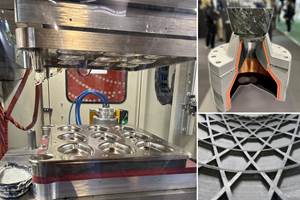Thermoplastic thin-ply UD tapes drive high versatility, scalability
CAMX 2025: A+ Composites is featuring thin-ply UD TPC tapes engineered with the inherent benefits of thermoplastics, but with individual ply thicknesses below 50 µm and fiber volume contents up to 68%.
Share
Source | A+ Composites
Only a few fibers thick and thinner than a human hair, ’s (Weselberg, Germany) new generation of thin-ply unidirectional (UD) tapes target new standards in thermoplastic composites (TPC). Designed with high-performance matrix systems such as polycarbonate (PC), polyamide 12 (PA12), polyamide 6 (PA6) and polyphenylene sulfide (PPS), these tapes enable the production of very lightweight, durable and recyclable components.
With individual ply thicknesses below 50 µm and fiber volume contents of up to 68%, the tapes enable precise laminate construction and high structural performance. Each tape is engineered with a smooth surface and features an integrated thin polymer top layer. This added layer, says A+ Composites, accelerates welding and consolidation during processing, making these thin-ply tapes faster to process than conventional UD tapes, which is ideal for high-throughput production environments.
The tapes are optimized for use in automated processes such as automated fiber placement (AFP), automated tape laying (ATL) and also Fiber Forged Technology. Their drapability and optimal surface quality reduce voids and ensure high optical and mechanical part quality with minimal postprocessing.
Thanks to their thin-ply construction, these tapes are ideal for ultra-thin structures with, for example, total laminate thicknesses under 300 µm of a five-ply layup — well suited for applications in high-performance sports equipment and aerospace parts, and functional components in consumer electronics, where weight, thickness and mechanical integrity are critical. They also bring with them the inherent benefits of thermoplastic matrices — such as fast cycle times, weldability and impact resistance.
The tapes are available with a wide range of fibers, like AGY S2 glass fiber or carbon fibers — high-tenancy, intermediate modulus, ultra-high tenacity and high modulus carbon fibers. A+ Composites can also customize to customer needs.
Related Content
-
Bladder-assisted compression molding derivative produces complex, autoclave-quality automotive parts
HP Composites’ AirPower technology enables high-rate CFRP roof production with 50% energy savings for the Maserati MC20.
-
Low-cost, efficient CFRP anisogrid lattice structures
CIRA uses patented parallel winding, dry fiber, silicone tooling and resin infusion to cut labor for lightweight, heavily loaded space applications.
-
The potential for thermoplastic composite nacelles
Collins Aerospace draws on global team, decades of experience to demonstrate large, curved AFP and welded structures for the next generation of aircraft.
Related Content
Bladder-assisted compression molding derivative produces complex, autoclave-quality automotive parts
HP Composites’ AirPower technology enables high-rate CFRP roof production with 50% energy savings for the Maserati MC20.
Read MoreLow-cost, efficient CFRP anisogrid lattice structures
CIRA uses patented parallel winding, dry fiber, silicone tooling and resin infusion to cut labor for lightweight, heavily loaded space applications.
Read MoreThe potential for thermoplastic composite nacelles
Collins Aerospace draws on global team, decades of experience to demonstrate large, curved AFP and welded structures for the next generation of aircraft.
Read MoreJEC World 2024 highlights: Thermoplastic composites, CMC and novel processes
CW senior technical editor Ginger Gardiner discusses some of the developments and demonstrators shown at the industry’s largest composites exhibition and conference.
Read MoreRead Next
Next-gen fan blades: Hybrid twin RTM, printed sensors, laser shock disassembly
MORPHO project demonstrates blade with 20% faster RTM cure cycle, uses AI-based monitoring for improved maintenance/life cycle management and proves laser shock disassembly for recycling.
Read MoreUltrasonic welding for in-space manufacturing of CFRTP
Agile Ultrasonics and NASA trial robotic-compatible carbon fiber-reinforced thermoplastic ultrasonic welding technology for space structures.
Read MoreScaling up, optimizing the flax fiber composite camper
Greenlander’s Sherpa RV cab, which is largely constructed from flax fiber/bio-epoxy sandwich panels, nears commercial production readiness and next-generation scale-up.
Read More









